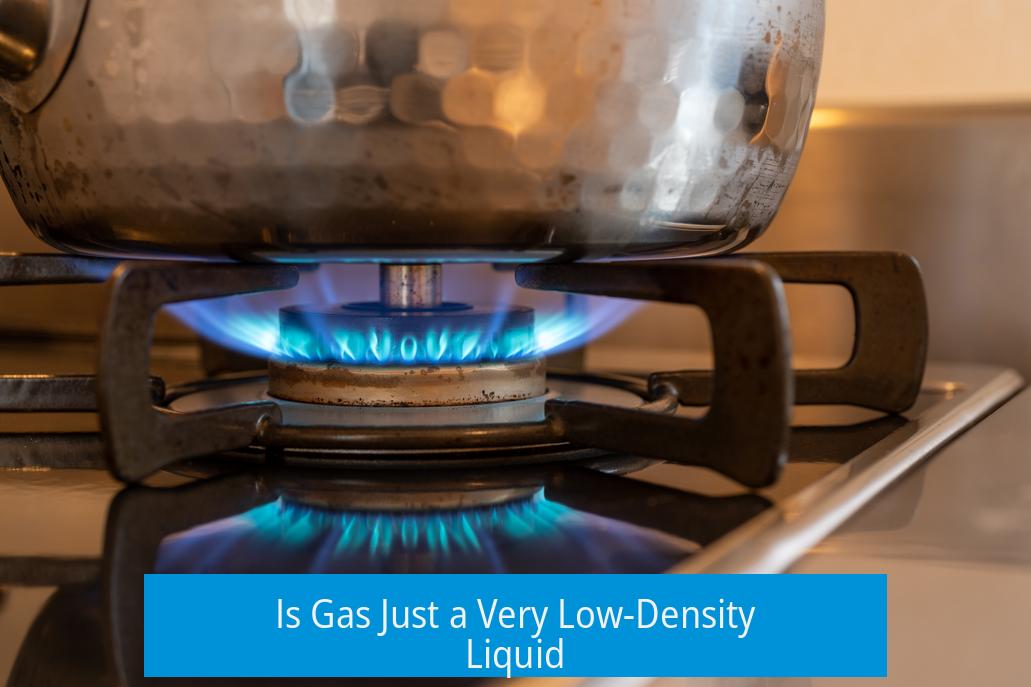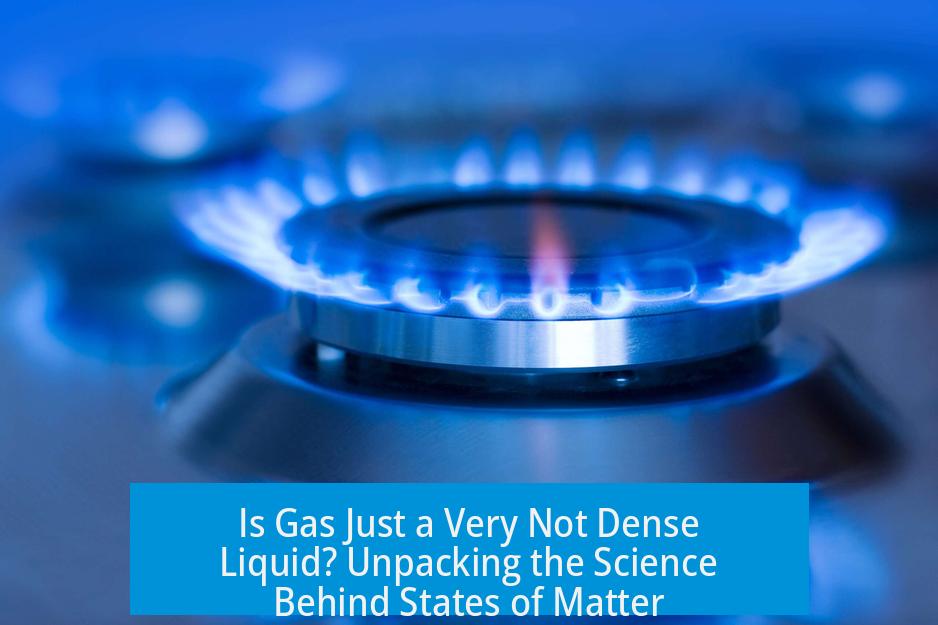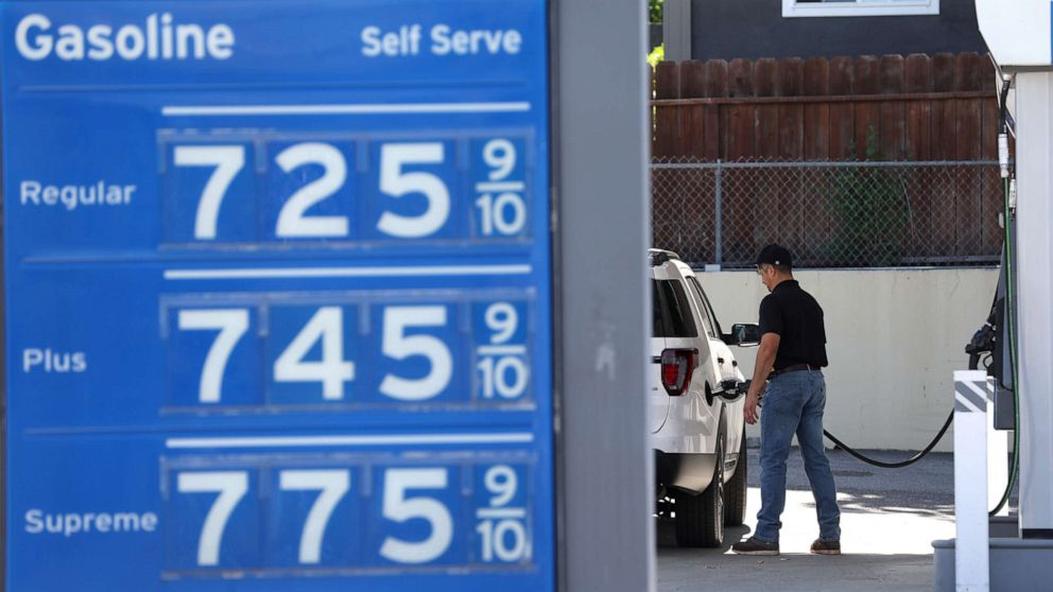Is Gas Just a Very Low-Density Liquid?

Gas is not simply a very low-density liquid; it is a distinct state of matter with fundamental differences in physical properties, molecular arrangement, and behavior.
Fundamental Differences Between Gas and Liquid
Gases and liquids share some traits but differ substantially in volume occupation and compressibility. A liquid has a defined surface and occupies a fixed volume. Conversely, a gas fills its container entirely, lacking a defined surface or volume limitation.
- Volume and Surface: Liquids have a distinct surface boundary, while gases do not; gases expand to fill the entire space available.
- Compressibility: Gases compress easily under pressure, while liquids are almost incompressible.
- Density: While gases generally exhibit lower densities than liquids, labeling a gas as “low-density liquid” is inaccurate since this overlooks molecular characteristics and fluid dynamics.
Shared Properties as Fluids
Both gases and liquids fall under the category of fluids because they take the shape of their container rather than maintaining a fixed shape. This feature implies molecular mobility within both states, though the extent and forces vary.
- Both gases and liquids lack a fixed shape and respond to container boundaries.
- This fluidity relates to molecules not being locked into rigid lattice positions, enabling flow and shape change.
Molecular and Thermodynamic Contrasts
The molecular arrangements in gases and liquids differ drastically, underpinning their different physical properties.
| Property | Liquids | Gases |
|---|---|---|
| Molecular Proximity | Close proximity with moderate order; molecules held by attractive forces. | Far apart with no fixed arrangement; kinetic energy dominates inter-molecular attractions. |
| Intermolecular Forces | Secondary bonds maintain structure and surface tension. | Negligible attractive forces; molecules move independently. |
| Kinetic Energy | Lower, molecules can stay together. | High enough to overcome attractions, allowing free motion. |
| Compressibility | Very low; the volume is nearly fixed. | High; gases respond significantly to pressure changes. |
Temperature and pressure govern whether molecules act as gas or liquid, explaining phase transitions between these states. At conditions above a material’s critical point, the distinct liquid and gas phases disappear into a supercritical fluid phase, an intermediate state.
Phase Behavior Beyond Gas and Liquid

Beyond gases and liquids, materials exhibit other states based on pressure and temperature. The supercritical fluid is notable for lacking a clear liquid-gas boundary.
- Supercritical fluids share properties of both gases and liquids.
- They do not exhibit a defined surface or volume limitations.
- The critical point marks the temperature and pressure beyond which gas and liquid phases merge.
Physical Behavior Distinguishing Gas from Liquid
Gas and liquid differ clearly in how they occupy space:
- Gas expands to fill any available volume completely.
- Liquid volume remains nearly constant, confined to a fixed amount of space.
- Liquids display surface tension, evidenced by a distinct surface layer.
- Gases lack surface tension and do not form a surface within the container.
Misunderstanding these differences often leads to the misconception that gases are just light liquids. This simplification ignores the molecular kinetic energy and intermolecular forces responsible for the unique behaviors of gases and liquids.
Summary of Key Differences and Concepts
- Gas is a compressible fluid without a defined surface; liquid is incompressible and has a distinct surface.
- Molecular forces keep liquid molecules close; gas molecules are far apart due to dominant kinetic energy.
- Gases fill containers entirely; liquids maintain a fixed volume.
- Fluids include both gases and liquids but differ fundamentally in physical properties.
- Temperature and pressure determine the phase; beyond the critical point, liquid and gas distinctions vanish.
Conclusion
Gas is not simply a low-density version of liquid. The state of matter gas holds unique traits linked to molecular spacing, energy, and interaction forces. Liquids and gases behave differently because of these factors rather than just density differences. Understanding these distinctions clarifies their roles within physics and chemistry.
Is Gas Just a Very Not Dense Liquid? Unpacking the Science Behind States of Matter

Short answer: No. Gas is not just a very low-density liquid. While that sounds like a neat shortcut, it doesn’t quite hit the mark scientifically. Gases and liquids share some similarities, but their core properties and molecular behavior set them apart sharply. Let’s dig into the juicy details—without any fluff.
Imagine you’re staring into a glass of water and a balloon filled with air. You might think gas is just water spread so thin it expands infinitely. But gases don’t just spread thin—they behave fundamentally differently. Here’s why.
The Grand Divide: Volume and Surface
The big, glaring difference between gas and liquid lies in volume occupation and surface definition. Liquids have a fixed volume and a defined surface. Pour water into a cup, and it fills the shape but never overflows unless you add more. Liquids sit there with a neat boundary.
Gases? Forget fixed volume or boundaries. Gas expands to fill every corner of its container, whether it’s a tiny bottle or a stadium. It never has a defined surface inside a container—it just spreads out like your neighbor’s loud music at 2 AM: everywhere.
Compressibility: Squeeze Me, Don’t Squeeze Me
This one’s a game-changer. Gases compress easily; liquids almost don’t. Try squeezing water into a smaller volume—it mostly laughs back at you, resisting compression. Air, on the other hand, loves to squish.
Because gas molecules have lots of space between them, pushing them closer changes gas volume readily. Liquids, with their tightly packed molecules, don’t allow this behavior. This is a key physical trait separating these two fluids.
Molecular Drama: Forces and Arrangement
At the microscopic level, molecules tell the real story. In liquids, molecules cluster together, held tight by attraction forces—secondary bonds, if you want the jargon. These forces give liquids structure but still allow flow. Picture a crowded party where everyone sticks close but can still move around.
In gases, molecules are much freer, zooming around with kinetic energy so high that the few tiny attractions between them barely count. It’s like a wild rave—everyone moves fast and independently with little regard for their neighbors.
Temperature and pressure can shift these relationships. Raise or lower them enough, and a substance might change state—liquid to gas or vice versa—but that shift doesn’t imply gas is a dilute liquid; it reflects completely different molecular conditions.
Fluidity and Shape: What Makes Them Similar

Here’s where the confusion seeds grow: both gases and liquids are fluids, meaning they flow and take the shape of their container. Neither has a fixed shape like solids. This property might trick you into thinking gases are just “diluted” liquids, but it’s a superficial similarity.
The real kicker? Fluids are defined by how their molecules move—not by how dense they are. Gas molecules move freely and independently; liquid molecules are more clingy but still mobile. “Fluid” is a broad club that admits several diverse members.
Misconceptions and Myths: Let’s Clear the Air
“Is gas a very not dense liquid? That would be like calling a solid a super dense liquid!”
Exactly. Density alone doesn’t define the state of matter. Calling gas a “not dense liquid” ignores other critical factors like molecular forces, volume occupancy, and compressibility. The technical name for this misunderstanding is oversimplification—and yes, it can be misleading.
Not all gases behave the same way, either. Helium, for instance, is famous for not caring much about pressure or temperature changes (unless extreme). Liquids don’t act that defiant.
Beyond the Usual: The Supercritical Fluid
Still can’t get enough? Science tosses a wildcard into the mix: the supercritical fluid. Above a specific temperature and pressure, the clear line between liquid and gas blurs. A supercritical fluid shares qualities of both—it can diffuse through solids like a gas and dissolve substances like a liquid.
This “neither-nor” state shows that the world of matter is richer than a simple gas-liquid binary. It’s a hint that nature loves to keep us guessing.
What Does This Mean Practically?
- If you’re designing fuel systems, knowing that gases compress is vital to avoid explosions.
- Chemists need to understand molecular attractions to predict reactions in different states.
- Weather models rely on gas behavior—gases fill the atmosphere, not a fixed volume, unlike liquid oceans.
- Everyday tasks—from breathing to boiling water—depend on these state distinctions.
Calling gas “a not dense liquid” is like calling your treadmill a “very slow car.” They may seem related but operate on entirely different principles.
Wrapping It Up
So, is gas just a very not dense liquid? No. Despite sharing the fluid label, they are distinct states of matter defined by fundamental differences in volume, molecular forces, compressibility, and behavior. Next time you watch steam rise or a balloon inflate, remember the fascinating science behind why gas acts the way it does. It’s not just water spread thin—it’s a whole different molecular dance.
Intrigued? Grab a balloon. Squeeze it lightly. Now pour a glass of water. Feel the difference? That’s physics inviting you to keep exploring.
Is a gas just a very low-density liquid?
No, gases and liquids differ fundamentally. Gases fill the entire volume of their container and have no defined surface. Liquids have a fixed surface and only fill part of a container.
Why can gases be compressed but liquids cannot?
Gas molecules move freely with large spaces between them, so they compress easily. Liquids have closer molecules held by attractive forces, making them much less compressible.
Do gases and liquids share any common properties?
Both gases and liquids are fluids, meaning they take the shape of their container. However, their molecular arrangements and behaviors differ significantly.
How do molecular forces differ between gases and liquids?
In liquids, molecules are close with noticeable attractive forces keeping them together. In gases, molecules move independently and kinetic energy overcomes these forces.
Can a substance be neither a gas nor a liquid?
Yes, supercritical fluids exist beyond traditional states. They show properties of both gases and liquids, appearing neither completely liquid nor gas.





Leave a Comment